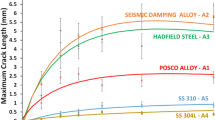Results are presented from a comparative analysis of the main mechanisms of internal friction in high-damping alloys based on the Zn – Al system, cast iron with flaked graphite, and iron alloys that exhibit internal friction of a magnetomechanical nature. A study is made of the damping capacity of alloys Zn – 26% Al, SCh25, and Fe – 5% Cr – 3% Al and steel 45, which are typical representatives of the types of materials in question. Their set of physico-mechanical properties is determined with allowance for damping capacity.

Similar content being viewed by others
References
M. Tagamai, T. Ohtani, and T. Usami, “Effects of heat treatment, contents of Cu and Mg, and rolling reduction on the damping capacity and mechanical properties of Zn – Al alloy,” J. Jpn. Inst. Light Metals, 38, 107 – 113 (1988).
A. I. Skvortsov, “Mechanical and damping properties of zinc – aluminum alloys,” Izv. Vyssh. Uchebn. Zaved., Tsvetn. Met., No. 1, 118 – 122 (1991).
A. I. Skvortsov, “Effect of alloying, heat treatment, and deformation on the structure and properties of Zn – Al damping alloys,” Metalloved. Term. Obrab. Met., No. 9, 27 – 29 (1996).
A. I. Skvortsov, “Structure formation and internal friction in non-equilibrium alloys based on zinc and aluminum,” Izv. Akad. Nauk, Ser. Fiz., 61(2), 298 – 303 (1997).
A. I. Skvortsov, “Electron-microscope analysis of the structure of fine-crystalline damping alloys based on zinc – aluminum,” in: Nanotechnologies of Functional Materials: Proc. International Scientific-Technical Conference [in Russian], Izd-vo Politekh. Univ., St. Petersburg (2010), pp. 269 – 271.
V. I. Prosvirin and N. N. Morgunova, “Effect of the structure of steel on the relative damping of torsional vibrations,” in: New Studies on the Strength of Machine-Building Materials, TsNIITMash Works [in Russian], Mashgiz, Moscow (1952), Vol. 49, No. 6, pp. 48 – 102.
E. Pivovarskii, High-Quality Cast Iron [in Russian], Metallurgiya, Moscow (1965), Vol. 1.
V. I. Litovka, A. A. Snezhko, A. P. Yakovlev, et al., Fatigue Strength of Cast Iron [in Russian], Naukova Dumka (1973).
M. S. Blanter, I. S. Golovin, S. A. Golovin, et al., Mechanical Spectroscopy of Metallic Materials [in Russian], MIA, Moscow (1994).
S. A. Golovin, A. Pushkar, and D. M. Levin, Elastic and Damping Properties of Metallic Structural Materials [in Russian], Metallurgiya, Moscow (1987).
A. I. Skvortsov, “Mechanism of intensive internal friction in iron alloys with flake graphite,” Fiz. Met. Metalloved., 97(1), 102 – 106 (2004).
A. I. Skvortsov, “Role of the crystalline and magnetic structures in the development of high magnetomechanical damping in iron alloys,” Ibid., 75(6), 118 – 124 (1993).
A. I. Skvortsov, “Structural mechanism of magnetomechanical damping in bcc iron alloys,” Izv. Akad. Nauk, Ser. Fiz., 57(11), 159 – 162 (1993).
A. I. Skvortsov, “Mobility of domain boundaries in bcc iron alloys during magnetomechanical damping,” Fiz. Met. Metalloved., 77(4), 15 – 19 (1994).
A. I. Skvortsov, “Effect of structure on the damping capacity and mechanical properties of iron alloys with magnetomechanical damping,” Metalloved. Term. Obrab. Met., No. 5, 18 –25 (2004).
A. I. Agapov, V. M. Kondratov, A. I. Skvortsov, et al., “Structure and physico-mechanical properties of monotectoid alloys of the Zn – Al system after different types of treatment,” Deformatsiya Razrushenie Mater., No. 8, 28 – 31 (2007).
A. I. Skvortsov, “Damping properties and structure of quenched gray iron,” Metally, No. 1, 116 – 119 (1991).
A. I. Skvortsov, “Characteristics of the physico-mechanical properties of machine-building materials that account for damping,” Vestn. Mashinostr., No. 4, 16 – 19 (2004).
D. W. James, “High damping metals for engineering applications,” Mat. Sci. Eng., 4(1),1–8 (1969).
A. I. Skvortsov, Creation of High-Damping Iron and Zinc – Aluminum Alloys and Principles of a Technology for Their Heat Treatment, Author’s Abstract of Doctoral’s Thesis [in Russian], UGTU, Ekaterinburg (1995).
Author information
Authors and Affiliations
Corresponding author
Additional information
Translated from Metallovedenie i Termicheskaya Obrabotka Metallov, No. 5, pp. 42 – 45, May, 2012.
Rights and permissions
About this article
Cite this article
Skvortsov, A.I. Analysis of inelasticity in high-damping Zn – Al alloys, gray irons, and iron alloys with internal friction of a magnetomechanical nature. Met Sci Heat Treat 54, 249–252 (2012). https://doi.org/10.1007/s11041-012-9491-6
Published:
Issue Date:
DOI: https://doi.org/10.1007/s11041-012-9491-6




